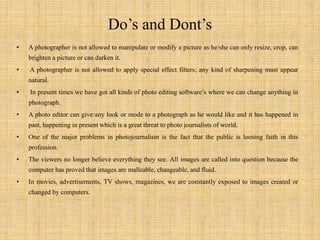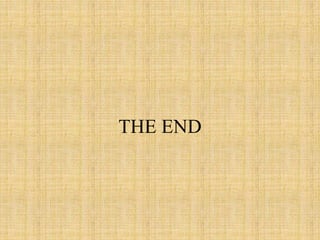FEATURE PHOTOGRAPHY
- 1. Feature Photography Rijitha R Assistant Professor Department of Media Studies
- 2. What is Feature Photography? • Feature photography is one of three major categories of work captured by working news photographers. • The other two major categories are of course news and sport. • There are almost as many definitions of a feature photograph as there are photographers involved in the genre. • However, a feature photograph might be described as a news image that supplements the headline stories - one that has no compelling reason to run but which provides further in-depth cover for news or recent-news story. • When an important person or significant event has recently been in the headline news, an editor may decide to run a feature article based upon the background to the original story. • A feature photographer might therefore seek to show a particular person at home in their family environment, perhaps talking about their lives and how events led to their appearance in the news headlines. • The stories told in this way may not be of particular importance individually, but cumulatively they portray our culture. • They may also add a positive side to stories that balances predominantly negative news
- 3. Feature Photography (Contd) • FEATURE story in Journalism refers to any human interest stories / soft news. • Features discuss various topics, from Travelogue, How-to recipes, services, gadgets, Wildlife expeditions, etc. It need not necessarily focus on any current/latest issues and portrays the writer’s point of view/ viewpoint. • PHOTO FEATURES consists of a series or collection of photo which are interwoven to convey a story without any need for captions to convey through words. • Photo features appears in newspapers, magazines and web contents. • These photos don't need any words to explain since they speak for themselves, • Photo features got its shape during the WW2 when Photojournalists carried their cameras and other gears and gadgets to the war scenes to capture the flights of the commoners, destructions, lose of lives, struggle of soldiers, etc.
- 4. Do’s and Dont’s • A photographer is not allowed to manipulate or modify a picture as he/she can only resize, crop, can brighten a picture or can darken it. • A photographer is not allowed to apply special effect filters; any kind of sharpening must appear natural. • In present times we have got all kinds of photo editing software’s where we can change anything in photograph. • A photo editor can give any look or mode to a photograph as he would like and it has happened in past, happening in present which is a great threat to photo journalists of world. • One of the major problems in photojournalism is the fact that the public is loosing faith in this profession. • The viewers no longer believe everything they see. All images are called into question because the computer has proved that images are malleable, changeable, and fluid. • In movies, advertisements, TV shows, magazines, we are constantly exposed to images created or changed by computers.
- 5. How to take pictures for photo feature • We should ask for permission and introduce our self before taking a photo of any personality. Never take a photograph of a child without the permission of parents. • Be sensitive when to take a photograph. Never take the photograph that would hurt anyone as it is the matter of ethics. • Watch for detail that would diminish the effectiveness of your photos. Do not pose the subject in front of a bush so it looks as though leaves are growing out of his head. • Take candid photos not posed ones as much as possible. Candid photos are much interesting. • Watch the lighting. Do not pose the subject with a strong light source behind them. The light whether sunlight or artificial light will wash out the subject. • 6. Whenever we submit photo with a manuscript, we must provide caption for the photo.
- 6. Joseph Pulitzer • Joseph Pulitzer, (born April 10, 1847, Makó, Hung.—died Oct. 29, 1911, Charleston, S.C., U.S.), American newspaper editor and publisher who helped establish the pattern of the modern newspaper. • He was an American journalist and publisher who created, along with William Randolph Hearst, a new and controversial kind of journalism. ... • He was committed to raising the standards of the journalism profession. • Pulitzer was the founder of the Pulitzer Prize, the most prestigious award in American journalism. • In his time he was one of the most powerful journalists in the United States.
- 7. Pulitzer Prize for Feature Photography 1968: Toshio Sakai, United Press International,for his Vietnam War combat photograph, 'Dreams of Better Times.'“ Photo depicts a scene from a camp of U.S troops in South-Vietnam. The soldier in the foreground slept on a pile sand bags while his comrade in the background was watching guard. The two troops were of the First Away Division and rested after heavy sniper and mortar fire. They were wearing Ponchos to stay dry even though the Moonson was pouring ceaselessly. The poncho was versatile: it also kept away the red ants. Another advantage was that an injured soldier in a poncho was easy to pull away from the action. The two troops were taking this rest at the Landing Zone Rufe about 36 miles northeast of Phuc Vinh. The Moonson was just one of the obstacles to The American troops which they were not used to and which was therefore difficult to handle. With reference to the photograph’s message, the sleeping G.I was perhaps dreaming of a time without rain and without war. Feature Photography 1968
- 9. 1973: Brian Lanker, Topeka Capital-Journal, "for his sequence on child birth, as exemplified by his photograph, 'Moment of Life.'“ Brian Lanker was a young, single photographer at the Topeka Capital-Journal, intrigued by the Lamaze method of childbirth. It took him six months to find a Kansas couple willing to be photographed. Jan. 27, 1972: Lanker was in the delivery room with parents-to-be Lynda and Jerry Coburn. “During early labor,” he said, “it was obvious to them that I was there. Later on, you have a bunch of doctors and nurses and I was able to blend in.” But the photographer was “so caught up with the moment and the emotion,” he needed a kind of “sixth sense” to stay focused. “Fortunately, your professionalism and artistry take over and allow you to do the work.” Tiny Jacki Lynn Coburn arrived, and Lanker captured “the incredible moment” — a baby’s first breaths, a father’s look, a mother’s smile. Feature Photography – 1973
- 11. 1983: James B. Dickman, Dallas Times Herald, "for his telling photographs of life and death in El Salvador.“ Feature Photography 1983
- 12. "Kevin Carter, a free-lance photographer for a picture first published in The New York Times of a starving Sudanese girl who collapsed on her way to a feeding center while a vulture waited nearby. Kevin Carter’s Pulitzer Prize winning photo taken in 1994 during the Sudan famine. the picture depicts a famine stricken child being stalked by a vulture. The child is moving towards a United Nations food camp, located a kilometer away. Three months later, and only weeks after being bestowed with the Pulitzer prize, Kevin Carter committed suicide. Feature Photography – (1994)
- 14. Awarded to Deanne Fitzmaurice of San Francisco Chronicle for her sensitive photo essay on an Oakland hospital’s effort to mend an Iraqi boy nearly killed by an explosion. The mission to save Saleh brought him and his father to Children’s Hospital Oakland, leaving his pregnant mother and two younger sisters behind in Iraq. The explosion had ripped open Saleh’s abdomen, torn off his right hand and most fingers on his left, blown out his left eye and killed his older brother. Feature Photography 2005
- 16. Reuters photography staff won 'Best Feature Photography' for their shocking photographs that exposed the world to the violence Rohingya refugees faced in fleeing Myanmar. Mohammed Taher, 50, a Rohingya refugee holds his son Mohammed Shoaib, 7, who was shot on his chest before crossing the border from Myanmar in August, as they sit outside a medical centre after seeing a doctor, at Kutupalong refugee camp near Coxas Bazar, Bangladesh Nov. 5, 2017.
- 18. 2018 winner (Reuters) A car runs into a crowd of counterprotesters during an attack at a rally in Charlottesville, Virginia. Photo by Ryan Kelly, The Daily Progress and winner of the Pulitzer Prize for Breaking News Photography.
- 19. THE END



















